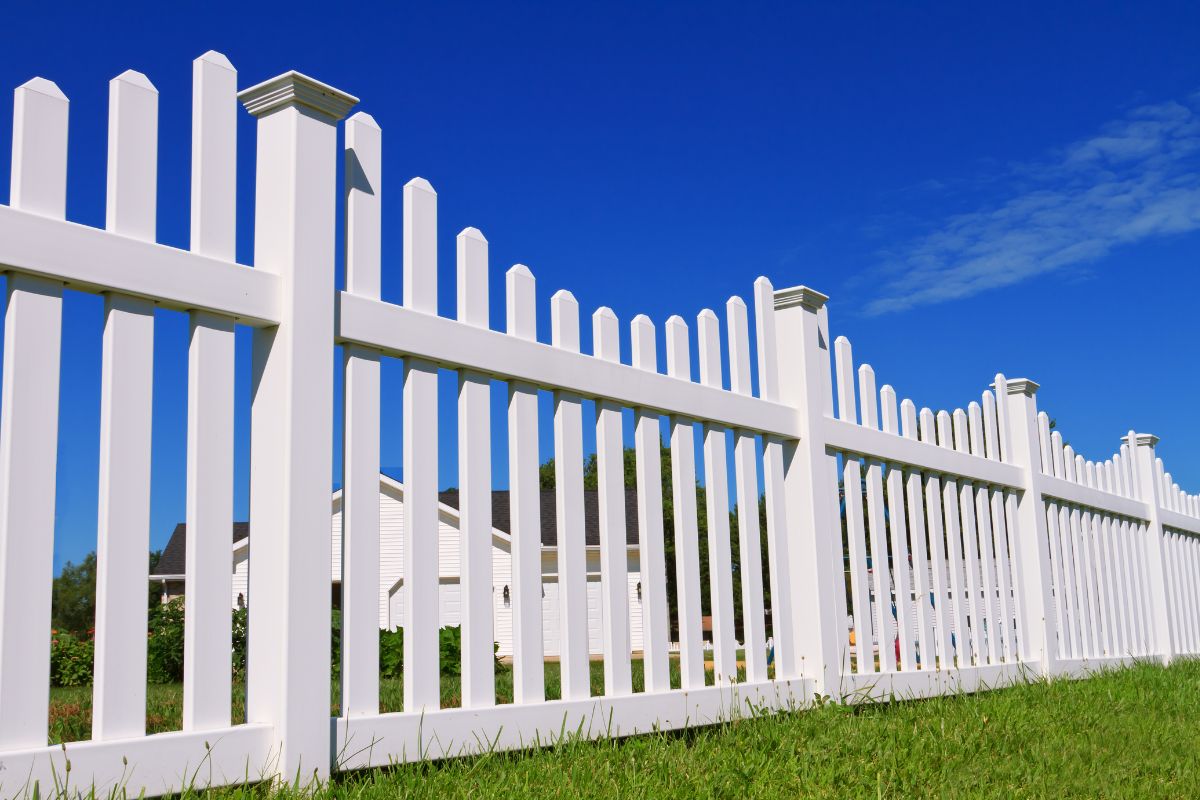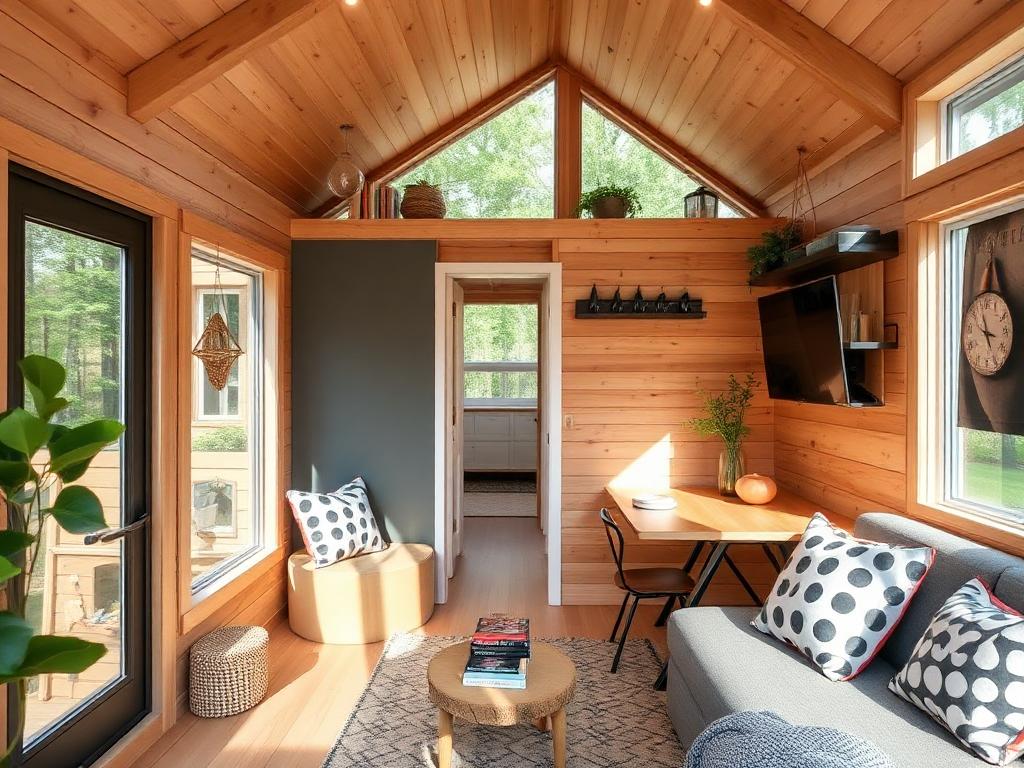One of the most crucial aspects of making the most of your limited yard is choosing the right fence. In this comprehensive guide, we'll explore space-saving fence designs that are perfect for tiny houses.
From stylish options to multifunctional designs, you'll find everything you need to create an outdoor space that feels open and inviting.
Why Fence Design Matters for Tiny Houses
A well-designed fence does more than just delineate your property. It can enhance privacy, add aesthetic appeal, and even provide additional storage or functional spaces.
For tiny house owners, making smart choices about fence design is essential to maximizing the usability and beauty of your outdoor area.
Enhancing Privacy Without Sacrificing Space
Privacy is often a top concern for tiny house dwellers. A tall, solid fence might seem like the best solution, but it can make your yard feel cramped.
Instead, consider semi-transparent options that provide privacy while maintaining an open feel. For example, lattice fences offer a balance of seclusion and airiness.
Adding Aesthetic Appeal
Your fence is one of the first things people notice about your property. Choosing a stylish design can significantly enhance your home's curb appeal. From modern minimalism to rustic charm, there are countless styles to match your tiny house aesthetic.
Maximizing Usable Space
Space is at a premium in tiny house living. Look for fence designs that serve multiple purposes, such as those with built-in planters, seating, or storage. This not only saves space but also adds functionality to your outdoor area.
Popular Fence Styles for Tiny Houses
With so many options available, choosing the right fence style can be overwhelming. Here, we'll break down some of the most popular and practical fence styles for tiny houses, highlighting their benefits and potential drawbacks.
Lattice Fences
Lattice fences are a popular choice for tiny houses because they provide a sense of privacy without making your yard feel enclosed. The crisscross pattern allows light and air to flow through, creating an open, airy atmosphere.
Benefits of Lattice Fences
- Privacy with Openness: The lattice design offers privacy while still allowing you to see through the gaps, creating a feeling of openness.
- Aesthetic Appeal: Lattice fences have a charming, classic look that can enhance the overall appearance of your tiny house.
- Versatility: You can use lattice panels in various ways, such as creating garden walls, adding height to existing fences, or even as trellises for climbing plants.
Drawbacks of Lattice Fences
- Durability: Lattice fences may not be as sturdy as solid wood or metal options, especially in areas with high winds or heavy snowfall.
- Maintenance: The intricate design can be more challenging to clean and maintain.
Vertical Garden Fences
A vertical garden fence is a fantastic space-saving solution that combines a traditional fence with a vertical garden.
This type of fence is perfect for tiny house owners who want to add greenery without taking up valuable ground space.
Benefits of Vertical Garden Fences
- Space Efficiency: Vertical gardens make the most of your limited outdoor space by utilizing vertical surfaces.
- Aesthetic Appeal: Lush, green plants can add a beautiful, natural element to your yard.
- Functional: In addition to serving as a fence, a vertical garden can provide fresh herbs, vegetables, or flowers.
Drawbacks of Vertical Garden Fences
- Maintenance: Vertical gardens require regular watering and care to keep the plants healthy.
- Initial Cost: Setting up a vertical garden can be more expensive than a traditional fence, especially if you need to install irrigation systems or special planters.
Pallet Fences
Pallet fences are an affordable and eco-friendly option that can be customized to suit your style and space needs. By repurposing old pallets, you can create a unique and functional fence that adds character to your tiny house.
Benefits of Pallet Fences
- Cost-Effective: Pallets are often available for free or at a low cost, making this an affordable fencing option.
- Eco-Friendly: Repurposing pallets is a great way to recycle materials and reduce waste.
- Customizable: Pallets can be painted, stained, or arranged in various ways to create a fence that suits your aesthetic.
Drawbacks of Pallet Fences
- Durability: Pallet wood may not be as durable as other fencing materials and may require more frequent maintenance or replacement.
- Uniformity: Pallets can vary in size and quality, making it challenging to create a uniform fence.
Space-Saving Features for Fences
When living in a tiny house, every square meter counts. Incorporating space-saving features into your fence design can help you make the most of your limited outdoor area.
Built-in Planters
Adding built-in planters to your fence is a great way to incorporate greenery without taking up ground space. This is particularly useful for tiny house owners who want to grow herbs, flowers, or small vegetables.
Benefits of Built-in Planters
- Space Efficiency: Planters attached to the fence free up ground space for other uses.
- Aesthetic Appeal: Greenery can add a vibrant, natural element to your fence, enhancing your outdoor area's visual appeal.
- Accessibility: Having plants at eye level can make gardening easier, especially for those with mobility issues.
Drawbacks of Built-in Planters
- Maintenance: Built-in planters require regular watering and care, which can be challenging if they are difficult to reach.
- Weight: Adding planters to your fence can increase its weight, potentially requiring additional support.
Storage Solutions
Incorporating storage into your fence design can help you keep your outdoor area tidy and organized. From shelves to cabinets, there are many ways to add storage to your fence.
Benefits of Storage Solutions
- Space Efficiency: Fence storage solutions can help you maximize your outdoor space by providing a place to store tools, toys, and other items.
- Organization: Keeping your outdoor area organized can make it feel more spacious and inviting.
- Aesthetic Appeal: Well-designed storage solutions can enhance the overall look of your fence.
Drawbacks of Storage Solutions
- Complexity: Adding storage to your fence can be more complicated than a simple fence installation, requiring additional planning and construction.
- Cost: Custom storage solutions can add to the overall cost of your fence.
Integrated Seating
Integrated seating is another space-saving feature that can add functionality and comfort to your outdoor area. Benches, chairs, and even swings can be incorporated into your fence design.
Benefits of Integrated Seating
- Space Efficiency: Built-in seating saves space by eliminating the need for separate outdoor furniture.
- Comfort: Having a comfortable place to sit can make your outdoor area more inviting and enjoyable.
- Aesthetic Appeal: Well-designed seating can enhance the overall look of your fence and outdoor space.
Drawbacks of Integrated Seating
- Complexity: Adding seating to your fence can be more complicated than a simple fence installation, requiring additional planning and construction.
- Maintenance: Built-in seating may require regular maintenance to keep it in good condition.
.jpeg)
Choosing the Right Materials for Your Fence
The materials you choose for your fence can have a significant impact on its durability, maintenance needs, and overall appearance.
Here, we'll explore some of the most popular materials for tiny house fences and their pros and cons.
Wood Fences
Wood is a classic and versatile material that can be used to create a wide range of fence styles. From traditional picket fences to modern slat designs, wood offers a natural and timeless appeal.
Benefits of Wood Fences
- Aesthetic Appeal: Wood fences have a warm, natural look that can enhance the overall appearance of your tiny house.
- Versatility: Wood can be painted, stained, or left natural to suit your style preferences.
- Customizability: Wood can be easily cut and shaped to create custom designs.
Drawbacks of Wood Fences
- Maintenance: Wood fences require regular maintenance, such as painting, staining, and sealing, to prevent rot and weather damage.
- Durability: Wood is susceptible to damage from insects, moisture, and extreme weather conditions.
Metal Fences
Metal fences, such as those made from aluminum, steel, or wrought iron, are known for their durability and low maintenance requirements. They can be used to create a wide range of styles, from modern to traditional.
Benefits of Metal Fences
- Durability: Metal fences are highly durable and resistant to damage from insects, moisture, and weather conditions.
- Low Maintenance: Metal fences require minimal maintenance, making them a practical choice for busy homeowners.
- Security: Metal fences can provide a high level of security, making them a good choice for those concerned about safety.
Drawbacks of Metal Fences
- Aesthetic Appeal: Metal fences can have a more industrial look that may not suit all tiny house styles.
- Cost: Metal fences can be more expensive than other materials, especially if you choose custom designs or high-end finishes.
Vinyl Fences
Vinyl fences are a popular choice for their low maintenance and versatile design options. They can mimic the look of wood, metal, or other materials while offering the benefits of durability and easy care.
Benefits of Vinyl Fences
- Low Maintenance: Vinyl fences require minimal maintenance and are resistant to rot, insects, and weather damage.
- Versatility: Vinyl can be molded to mimic the look of various materials, offering a wide range of design options.
- Durability: Vinyl is highly durable and can withstand harsh weather conditions without fading or cracking.
Drawbacks of Vinyl Fences
- Cost: Vinyl fences can be more expensive than other materials, especially for high-quality options.
- Aesthetic Appeal: Some people may prefer the natural look of wood or metal over vinyl.
Installing Your Space-Saving Fence
Once you've chosen the right design and materials for your space-saving fence, it's time to install it. Proper installation is crucial to ensuring your fence is sturdy, functional, and looks great. Here are some tips for a successful installation.
Planning and Preparation
Before you start digging post holes, it's essential to plan and prepare for your fence installation. This includes measuring your yard, marking the fence line, and checking for any underground utilities.
Measuring and Marking
- Measure Your Yard: Use a tape measure to determine the dimensions of your yard and mark the locations for your fence posts.
- Mark the Fence Line: Use stakes and string to outline the fence line, ensuring it's straight and even.
- Check for Utilities: Contact your local utility companies to locate any underground utilities before you start digging.
Gathering Materials and Tools
- Materials: Make sure you have all the necessary materials for your fence, including posts, panels, fasteners, and any additional features like planters or storage units.
- Tools: Gather the tools you'll need for the installation, such as a post-hole digger, level, tape measure, drill, and saw.
Installing Fence Posts
Fence posts are the foundation of your fence, so it's crucial to install them correctly. This involves digging post holes, setting the posts, and ensuring they are level and secure.
Digging Post Holes
- Depth and Width: Post holes should be at least one-third the length of the post and wide enough to allow for proper setting. Typically, this means a hole that's about 60 cm deep and 30 cm wide.
- Spacing: Space your post holes according to the length of your fence panels, usually about 2 to 2.5 meters apart.
Setting Fence Posts
- Level and Plumb: Use a level to ensure your posts are straight and plumb before setting them in place.
- Concrete: Fill the post holes with concrete to secure the posts. Allow the concrete to cure for at least 24 hours before attaching the fence panels.
Attaching Fence Panels
Once your posts are set, you can attach the fence panels. This involves securing the panels to the posts with screws or brackets and ensuring they are level and properly aligned.
Securing Panels
- Alignment: Make sure each panel is aligned with the top and bottom of the posts before securing it in place.
- Fasteners: Use screws or brackets to attach the panels to the posts, ensuring they are securely fastened.
Finishing Touches
- Gates and Latches: If your fence includes a gate, install it last, ensuring it swings freely and latches securely.
- Paint or Stain: If your fence is made of wood, consider painting or staining it to protect it from the elements and enhance its appearance.
Maintenance Tips for Your Space-Saving Fence
To keep your fence looking great and functioning well, regular maintenance is essential. Here are some tips for maintaining your space-saving fence.
Regular Cleaning
Keeping your fence clean can help prevent the buildup of dirt, mold, and mildew, which can cause damage over time.
Cleaning Wood Fences
- Mild Detergent: Use a mild detergent and water to clean your wood fence, scrubbing with a soft brush.
- Rinse: Rinse the fence thoroughly with a garden hose to remove any soap residue.
- Seal: Apply a sealant or stain to protect the wood from moisture and UV damage.
Cleaning Metal Fences
- Mild Soap: Use mild soap and water to clean your metal fence, scrubbing with a soft brush or sponge.
- Rust Removal: If you notice any rust spots, remove them with a wire brush and apply a rust-inhibiting primer and paint.
Cleaning Vinyl Fences
- Soap and Water: Clean your vinyl fence with soap and water, using a soft brush or cloth.
- Rinse: Rinse thoroughly to remove any soap residue.
Inspecting for Damage
Regularly inspecting your fence for damage can help you catch and repair issues before they become more serious.
Wood Fences
- Rot and Decay: Check for signs of rot and decay, especially at the base of the posts and along the fence line.
- Insects: Look for signs of insect damage, such as holes or sawdust.
Metal Fences
- Rust: Inspect for rust spots and remove them promptly to prevent further damage.
- Loose Fasteners: Check for any loose screws or brackets and tighten them as needed.
Vinyl Fences
- Cracks and Splits: Inspect for any cracks or splits in the vinyl, which can weaken the fence.
- Discoloration: Look for any discoloration or fading, which can be a sign of UV damage.
Seasonal Maintenance
Depending on your climate, your fence may require additional seasonal maintenance to keep it in good condition.
Winter Maintenance
- Snow and Ice: Remove snow and ice buildup from your fence to prevent damage from freezing and thawing cycles.
- Inspect for Damage: Check for any damage caused by winter weather, such as cracks or warping.
Summer Maintenance
- Heat and Sun: Protect your fence from sun damage by applying a UV-resistant sealant or paint.
- Inspect for Damage: Check for any damage caused by summer storms, such as loose panels or posts.
.jpeg)
Personal Experience: My Wood Fence Journey Around My Tiny House
As a tiny house owner and enthusiast, I've come to appreciate the unique challenges and rewards of making the most of limited space.
One of the most impactful decisions I made was installing a wood fence around my tiny house. It wasn't just about creating a boundary; it was about enhancing privacy, adding aesthetic value, and making my outdoor space functional.
Here, I'll share my journey with my wood fence, the lessons I learned, and my recommendations for other tiny house owners.
Choosing the Right Wood Fence
When I first moved into my tiny house, I knew I wanted a fence that would offer privacy without making my small yard feel confined.
After much research, I opted for a cedar wood fence. Cedar is known for its durability and natural resistance to insects and rot, which makes it an ideal choice for a low-maintenance yet beautiful fence.
Why Cedar?
- Durability: Cedar withstands the elements better than many other types of wood, which is crucial for long-term maintenance.
- Aesthetic Appeal: The rich, warm tones of cedar added a natural and inviting look to my yard.
- Sustainability: Cedar is a sustainable option, aligning with my eco-friendly tiny house lifestyle.
Installation: A DIY Adventure
Installing the fence was a project I decided to tackle myself, with the help of a few friends. It was a rewarding experience that allowed me to learn new skills and customize the fence to my specific needs.
Planning and Preparation
Before starting the installation, I spent time planning and preparing:
- Measurements: Accurately measuring the perimeter of my yard ensured I purchased the right amount of materials.
- Design: I chose a semi-transparent design with spaced boards to provide privacy while allowing light and air to flow through.
- Tools and Materials: Gathering all necessary tools (post-hole digger, level, drill) and materials (posts, panels, screws, sealant) in advance saved time and hassle.
The Installation Process
- Digging Post Holes: We dug holes about 60 cm deep and 30 cm wide, ensuring stability for the fence posts.
- Setting the Posts: Using a level, we ensured each post was straight before setting them in concrete.
- Attaching Panels: Once the posts were set, attaching the panels was straightforward. We used stainless steel screws to prevent rust.
- Finishing Touches: Applying a protective sealant to the wood helped guard against weather damage and extended the fence's lifespan.
While it's possible to install a fence yourself, hiring a professional can ensure the job is done correctly and safely. There are many fencing contractors such as Outstanding Fencing who can quickly and easily install your fence and do a professional job. If you're comfortable with DIY projects and have the necessary tools and skills, you can save money by installing the fence yourself.
Maintenance: Keeping the Fence in Top Shape
Maintaining the wood fence has been relatively straightforward, thanks to the initial choice of cedar and the protective sealant applied.
Regular Cleaning
- Routine Cleaning: I clean the fence every few months with a mild detergent and water, using a soft brush to remove dirt and grime.
- Rinse Thoroughly: A garden hose works well for rinsing off soap and ensuring the wood remains clean.
Annual Inspection
- Check for Damage: Each year, I inspect the fence for any signs of rot, insect damage, or loose screws.
- Reapply Sealant: To maintain the wood’s protective barrier, I reapply sealant annually. This helps prevent moisture damage and keeps the wood looking fresh.
Lessons Learned and Recommendations
Based on my experience, here are some recommendations for other tiny house owners considering a wood fence:
Choose the Right Wood
- Opt for Durable Wood: Cedar, redwood, and treated pine are excellent choices for their durability and resistance to pests and rot.
- Sustainability: Consider the environmental impact of your choice. Sustainable wood options like FSC-certified cedar are great for eco-conscious homeowners.
Plan Your Design Carefully
- Privacy vs. Openness: Think about how much privacy you need versus how much light and air you want to allow through the fence. A semi-transparent design can offer a good balance.
- Space-Saving Features: Incorporate built-in planters or vertical garden elements to maximize your limited space. This can add greenery and beauty without taking up ground space.
Consider DIY Installation
- Cost Savings: Installing the fence yourself can save a significant amount of money. However, be prepared for the physical work and time commitment.
- Customization: DIY installation allows you to customize the design to fit your specific needs and preferences.
Regular Maintenance is Key
- Protective Sealant: Applying a sealant annually can protect the wood from weather damage and extend the life of your fence.
- Routine Inspections: Regularly inspect your fence for any signs of damage and address them promptly to prevent more significant issues.
Final Thoughts
Installing a wood fence around my tiny house has been one of the best decisions I've made. It has created a private, functional, and aesthetically pleasing outdoor space that enhances my tiny house living experience.
With careful planning, thoughtful design, and regular maintenance, a wood fence can provide lasting benefits for any tiny house owner. Whether you choose to install it yourself or hire a professional, the right fence can transform your yard into a beautiful and useful extension of your tiny home.
Choosing the right fence for your tiny house is essential for maximizing your outdoor space and enhancing your home's overall appeal. By considering factors like privacy, aesthetics, and functionality, you can select a fence design that meets your needs and complements your tiny house lifestyle.
Whether you opt for a lattice fence, a vertical garden fence, or a pallet fence, incorporating space-saving features like built-in planters, storage solutions, and integrated seating can help you make the most of your limited yard.
With proper planning, installation, and maintenance, your space-saving fence will provide beauty and functionality for years to come.






Share: